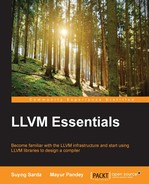The LLVM Compiler infrastructure project, started in 2000 in University of Illinois, was originally a research project to provide modern, SSA based compilation technique for arbitrary static and dynamic programming languages. Now it has grown to be an umbrella project with many sub projects within it, providing a set of reusable libraries having well defined interfaces.
LLVM is implemented in C++ and the main crux of it is the LLVM core libraries it provides. These libraries provide us with opt tool, the target independent optimizer, and code generation support for various target architectures. There are other tools which make use of core libraries, but our main focus in the book will be related to the three mentioned above. These are built around LLVM Intermediate Representation (LLVM IR), which can almost map all the high-level languages. So basically, to use LLVM's optimizer and code generation technique for code written in a certain programming language, all we need to do is write a frontend for a language that takes the high level language and generates LLVM IR. There are already many frontends available for languages such as C, C++, Go, Python, and so on. We will cover the following topics in this chapter:
- Modular design and collection of libraries
- Getting familiar with LLVM IR
- LLVM Tools and using them at command line
The most important thing about LLVM is that it is designed as a collection of libraries. Let's understand these by taking the example of LLVM optimizer opt. There are many different optimization passes that the optimizer can run. Each of these passes is written as a C++ class derived from the Pass class of LLVM. Each of the written passes can be compiled into a .o file and subsequently they are archived into a .a library. This library will contain all the passes for opt tool. All the passes in this library are loosely coupled, that is they mention explicitly the dependencies on other passes.
When the optimizer is ran, the LLVM PassManager uses the explicitly mentioned dependency information and runs the passes in optimal way. The library based design allows the implementer to choose the order in which passes will execute and also choose which passes are to be executed based on the requirements. Only the passes that are required are linked to the final application, not the entire optimizer.
The following figure demonstrates how each pass can be linked to a specific object file within a specific library. In the following figure, the PassA references LLVMPasses.a for PassA.o, whereas the custom pass refers to a different library MyPasses.a for the MyPass.o object file.

The code generator also makes use of this modular design like the Optimizer, for splitting the code generation into individual passes, namely, instruction selection, register allocation, scheduling, code layout optimization, and assembly emission.
In each of the following phases mentioned there are some common things for almost every target, such as an algorithm for assigning physical registers available to virtual registers even though the set of registers for different targets vary. So, the compiler writer can modify each of the passes mentioned above and create custom target-specific passes. The use of the tablegen tool helps in achieving this using table description .td files for specific architectures. We will discuss how this happens later in the book.
Another capability that arises out of this is the ability to easily pinpoint a bug to a particular pass in the optimizer. A tool name Bugpoint makes use of this capability to automatically reduce the test case and pinpoint the pass that is causing the bug.
